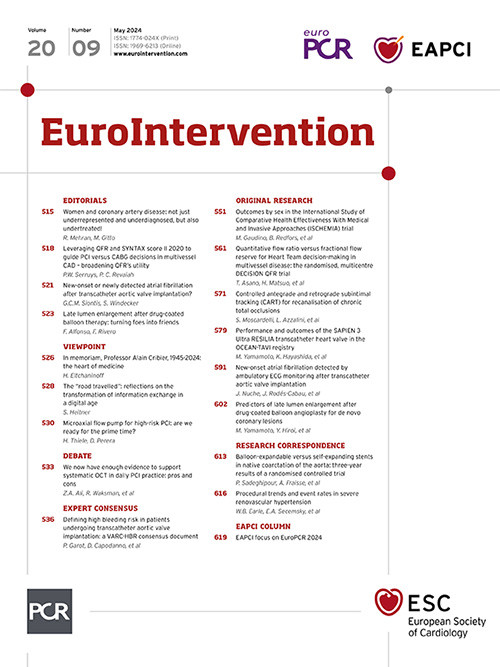Diagnosis of new-onset atrial fibrillation (AF) in elderly patients with severe symptomatic aortic stenosis undergoing transcatheter aortic valve implantation (TAVI) has important acute and long-term implications in clinical decision-making. In this issue of EuroIntervention, Nuche et al1 report the results of a multicentre study in patients with severe aortic stenosis and no previously known AF undergoing TAVI who were monitored by means of different methods of continuous ambulatory electrocardiogram (ECG) recording devices. The analysis was conducted retrospectively on prospectively collected data. New-onset AF was detected in 7% of the patients and resulted in the initiation of long-term oral anticoagulation therapy in half of these patients; it was not associated with impaired clinical outcomes up to 1 year of follow-up.
This study is published at a time when the widespread adoption of continuous rhythm monitoring devices has facilitated the identification of individuals with non-clinically overt manifestations of AF, leading to the recognition of a new entity within the AF spectrum called subclinical AF. The prevalence of subclinical AF increases with advancing age and may be as high as 30%, depending on the patient group and the method of AF ascertainment2. Subclinical AF has garnered increasing attention due to the widespread availability of wearable devices and its association with an increased risk of stroke. The estimates of newly detected AF in the TAVI population vary widely across studies of different ambulatory ECG monitoring methods, ranging from 14% (95% confidence interval [CI]: 10-19%) at 1-year follow-up to 25% (95% CI: 13-40%) at 2-year follow-up34. Nuche et al1 report considerably lower detection rates of AF of 7%. This finding should be carefully interpreted, as ambulatory ECG monitoring started the day after TAVI and lasted for a median time of only 14 days. It is apparent, especially in the elderly TAVI population with significant comorbidities (hypertension, chronic pulmonary disease, anaemia, cerebrovascular disease) representing established risk factors for AF, that the longer the duration of monitoring and the higher the risk of the population, the greater the detection rate of subclinical AF.
Understanding the impact of subclinical AF on clinical outcomes is crucial because of its potential association with adverse health consequences, especially in the elderly TAVI population. Each year, 16.9 million people worldwide suffer from stroke5, with the cause remaining undetermined in 20% to 40% of cases. Among unexplained strokes, undetected AF may be the cause in up to 30% of cases2. Of note, subclinical AF has been linked to an increased risk of cardiovascular mortality, impaired quality of life, and significant treatment implications. In the present study1, new detection of AF had no impact on hard clinical endpoints (all-cause mortality and stroke) after 1 year of follow-up, but it resulted in the initiation of oral anticoagulation in half of the patients. A previous meta-analysis of 13 studies (involving 13,094 TAVI patients) reported that newly detected AF during the first year following TAVI was associated with an increased risk of mortality (summary effect estimate of risk ratio 1.61; 95% CI: 1.35-1.98) and cerebrovascular events (risk ratio 1.79; 95% CI: 1.24-2.64)3. Notwithstanding, recent, large-scale clinical trials comparing direct oral anticoagulants with placebo or aspirin among patients with atrial high-rate episodes revealed consistent results reporting a significant reduction in stroke risk at the cost of a higher risk of major bleeding678.
Although the clinical and procedural predictors of subclinical AF have been identified, the pathophysiological substrate of “new-onset” AF after TAVI remains largely unknown. This gap in knowledge, along with the findings from large-scale studies on subclinical AF detection, raises the question of whether subclinical AF already exists before TAVI but is only detected with intensive monitoring following the intervention. Future studies should evaluate the role of long-term ambulatory ECG strategies in patients at risk during the earlier stages of aortic stenosis severity and its impact on downstream oral anticoagulation or alternative prophylactic interventions (i.e., left atrial appendage occlusion). This will allow us to better appreciate the prevalence of subclinical AF, irrespective of the TAVI procedure itself, and its long-term clinical impact in this specific group of patients.
Conflict of interest statement
S. Windecker reports research, travel or educational grants to the institution from Abbott, Abiomed, Amgen, AstraZeneca, Bayer, Biotronik, Boehringer Ingelheim, Boston Scientific, Bristol-Myers Squibb, Cardinal Health, Cardiovalve, CorFlow Therapeutics, CSL Behring, Daiichi Sankyo, Edwards Lifesciences, Guerbet, Infraredx, Janssen-Cilag, Johnson & Johnson, Medicure, Medtronic, Merck & Co., Miracor Medical, Novartis, Novo Nordisk, Organon, OrPha Swiss, Pfizer, Polares, Regeneron, Sanofi-Aventis, Servier, Sinomed, Terumo, Vifor, and V-Wave; he has served as an advisory board member and/or member of the steering/executive group of trials funded by Abbott, Abiomed, Amgen, AstraZeneca, Bayer, Boston Scientific, Biotronik, Bristol-Myers Squibb, Edwards Lifesciences, Janssen, MedAlliance, Medtronic, Novartis, Polares, Recardio, Sinomed, Terumo, V-Wave, and Xeltis, with payments to the institution but no personal payments; and he has also been a member of the steering/executive committee group of several investigator-initiated trials that have received funding by industry without impact on his personal remuneration. G.C.M. Siontis has no conflicts of interest to declare.

